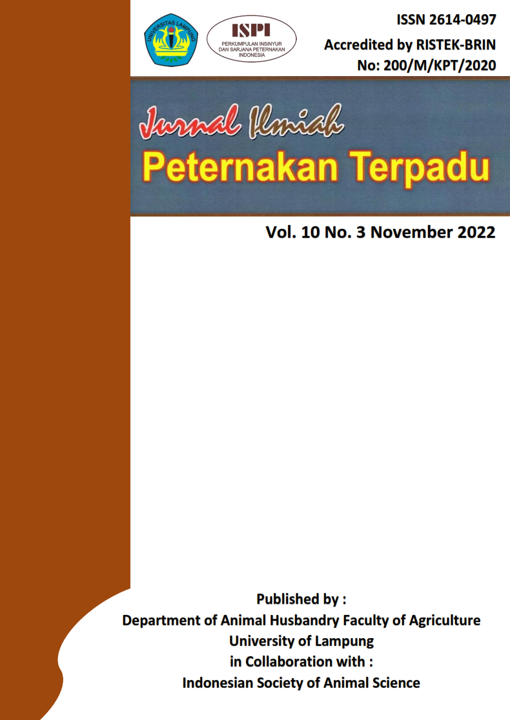Utilization of Duck Feet Gelatin with the Additional Glycerol as A Plasticizer on the Physical Properties of Edible Film
DOI:
https://doi.org/10.23960/jipt.v10i3.p289-299 Abstract View: 1325
Abstract View: 1325
Keywords:
Duck feet, Gelatine, Glycerol, Edible film, Physical propertiesAbstract
The packaging that is widely used is plastic packaging, but this material has a weakness that is difficult to decompose and isn’t biodegradable, therefore edible film can be an alternative primary packaging for food products. The material used consists of gelatine made from duck feet with the addition of various concentrations of glycerol. Duck feet is an underutilized portion of the animal's anatomy, yet they contain collagen, which has the potential to be the raw material for gelatine and edible films. The study was undertaken utilizing duck feet as a source of raw material, which was subsequently processed into gelatine for use in the production of edible films using different glycerol treatments. The treatments comprised of glycerol concentrations of P1 = 10%, P2 = 20%, P3 = 30%, P4 = 40%, P5 = 50%, and P6 = 60%. The findings indicated that the application of glycerol significantly affected the films' solubility, water absorption, and tensile strength (P<0.05), but didn’t significantly affect the elongation of edible films. (P>0.05). The optimal concentration of glycerol for edible film in this study was obtained by using 20% glycerol, with a physical characteristic value of 40.25% solubility, 24.23% water absorption, tensile strength is 0.57 MPa, and elongation is 90%.Downloads
References
Afifah, N., E. Sholichah, N. Indrianti, D.A. Darmajana. 2018. Pengaruh Kombinasi Plasticizer tehadap Karakterisasi Edible Film dari Karagenan dan Lilin Lebah. Biopropal Industri. 9(1): 49-60.
Arrieta, M. P., J. Lopez, S. Ferrandiz, M. Peltzer. 2013. Characterization of PLA-Limonene Blends for Food Packaging Applications. Polymer Testing. 32(4).
Ban, W., J. Song, D. S. Argyropoulos, L. A. Lucia. 2005. Improving the Physical and Chemical Functionally of Starch – Derived Films with Biopolymers. Journal Applied Polymer Science. 100: 2542-2548.
Bertuzzi, M. A., M. Armada, J. C. Gottifredi. 2007. Physicochemical Characterization of Starch Based Films. Journal Food Engineering. 82: 17-25.
Bourtoom, T. 2007. Plasticizer Effect on the Properties of Biodegradable Blend Film from Rice Starch-Chitosan. Songklanakarin. Journal Science and Technology 3(1): 149 – 165.
Chambi, H., C. Grosso. 2006. Edible Film Produced with Gelatin and Casein Cross-linked with Transgluminase. International Journal Food Res. 39: 458-466.
Fadillah, G., P. Putri, N. L. N. Azizah, Y. O. Purbayanto, T. E. Saraswati. 2013. Isolasi Gelatin dari Limbah Ceker Ayam sebagai Alternatif Bahan Pengawet Alami Bahan Makanan. Prosiding SNKTI. 2: 41-44.
Haris, M. A. 2008. Pemanfaatan Limbah Tulang Ikan Nila (Oreochromis niloticus) sebagai Gelatin dan Pengaruh Lama Penyimpanan pada Suhu Ruang. Fakultas Perikanan dan Ilmu Kelautan. Institut Pertanian Bogor. Bogor
Huda, W. N., W. Atmaka, E. Nurhartadi. 2013. Kajian Karakteristik Fisik dan Kimia Gelatin Ekstrak Kaki Ayam (Gallus gallus bankiva) dengan Variasi Lama Perendaman dan Konsentrasi Asam. Jurnal Teknosains Pangan. 2(3): 70-75.
Huri, D., C. N. Fithri. 2014. Pengaruh Konsentrasi Gliserol dan Ekstrak Ampas Kulit Apel terhadap Karakteristik Fisik dan Kimia Edible Film. Jurnal Pangan dan Agroindustri. 2(4): 29-40.
Japanesse Industrial Standard. 1975. Japanese Standards Association. 2(1707).
Laila, U. 2008. Pengaruh Plastiicizer dan Suhu Pengeringan terhadapp Sifat Mekanik Edible Film dari Kitosan. Laporan Penelitian Laboratorium Teknik pangan dan Bioproses. Jurusan Teknik Kimia Fakultas Teknik. UGM. Yogyakarta.
Maria, V. Debandi, N. Francois. 2016. Development of Biodegradable Films Based on Chitosan/Glycerol Blends Suitable for Biomedical Applications. Journal of Tissue Science & Engineering. 7(3):187.
Miwada, IN. S., I. N. Simpen, M. Hartawan, A. W. Puger, N. L. P. Sriyani. 2015. Karakteristik Gelatin dari Kulit Kaki Ternak dan Potensinya sebagai Edible Film. Majalah Ilmiah Peternakan. 18(3): 109 – 113.
Nugroho A.A., Basito, R. B. K. Anandito. 2013. Kajian Pembuatan Edible Film Tapioka dengan Pengaruh Penambahan Pektin Beberapa Jenis Kulit Pisang terhadap Karakteristik Fisik dan Mekanik . Jurnal Teknosains Pangan. 2(1): 73-79.
Osés, J., I. Fernández-Pan, M. Mendoza, J.I. Maté. 2009. Stability of the Mechanical Properties of Edible Films Based on Whey Protein Isolate During Storage at Different Relative Humidity. Food Hydrocolloids. 23(1): 125–131.
Poeloengasih, C.D, D.W. Marseno. 2003. Karakterisasi Edible film Komposit Protein Biji Kecipir dan Tapioka. Jurnal Teknologi dan Industri Pangan. 14(3): 224-230.
Putra, D. A., I. Amri, Irdoni. 2019. Sintesis Bioplastik Berbahan Dasar Pati Jagung dengan Penambaha Filler Selulosa Serat Daun Nanas (Ananas cosmosus). JOM FTEKNIK. 06(1): 1-8.
Setiani, W., T. Sudiarti, L. Rahmidar. 2013. Preparasi dan Karakterisasi Edible Film dari Poliblend Pati Sukun-Kitosan. Jurnal Kimia Valensi. 3(2): 100-109.
Sobral, P. J. A., F. C. Menegalli, M. D. Hubinger, M. A. Roques. 2001. Mechanical, Water Vapor Barrier and Thermal Properties of Gelatin Based Edible. J. Food Hydrocol. 15: 423-432.
Wiset, L., N. Poomsa-ad, P. Jomlapeeratikul. 2014. Effects of Drying Temperatures and Glycerol Concentrations on Properties of Edible Ilm from Konjac Lour. Journal of Medical and Bioengineering. 3(3): 171-174.
Zhong, Y., G. Patrick, J. Yongcan, X. Huining. 2020. Biodegradable Polymers and Green-based Antimicrobial Packaging Materials: A mini-review. Advanced Industrial and Engineering Polymer Research. 3: 27-35.
Downloads
Published
How to Cite
Issue
Section
License

Jurnal Ilmiah Peternakan Terpadu(JIPT) is licensed under a Creative Commons Attribution 4.0 International License.
Authors who publish with this journal agree to the following terms:
- Authors retain copyright and grant the journal right of first publication with the work simultaneously licensed under a Creative Commons Attribution License that allows others to share the work with an acknowledgement of the work's authorship and initial publication in this journal.
- Authors are able to enter into separate, additional contractual arrangements for the non-exclusive distribution of the journal's published version of the work (e.g., post it to an institutional repository or publish it in a book), with an acknowledgement of its initial publication in this journal.
- Authors are permitted and encouraged to post their work online (e.g., in institutional repositories or on their website) prior to and during the submission process, as it can lead to productive exchanges, as well as earlier and greater citation of published work (See The Effect of Open Access).





















